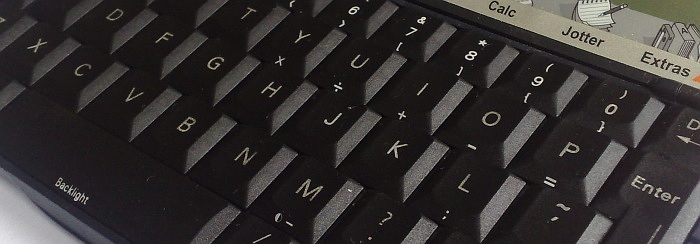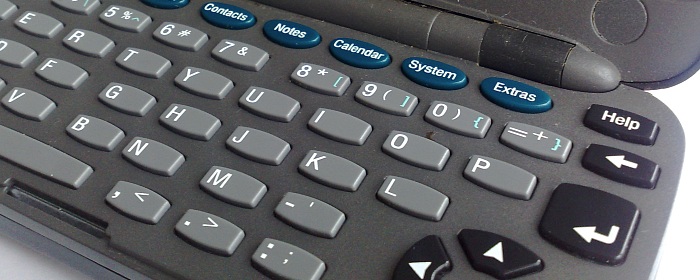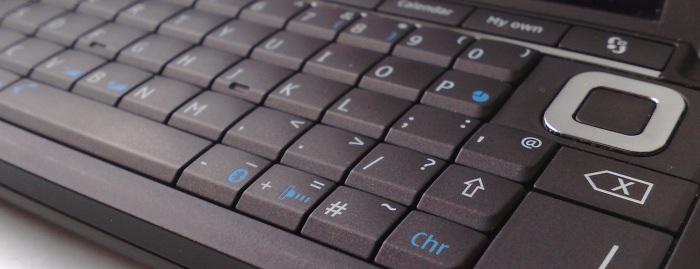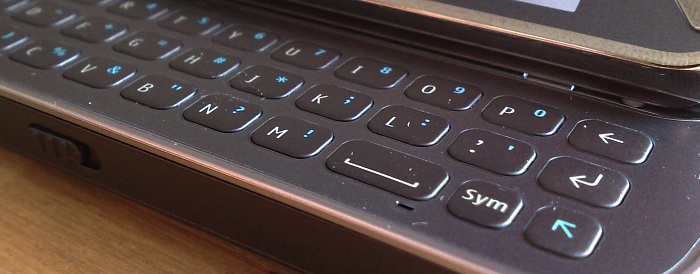There are, of course, as many different form factors for PDAs and smartphones as there are stars in the sky. Well, almost, and only if you count all the different subtle differences in weight and size as well. But at some point, you're to have to put information into this device, if only to scribble in a Calendar appointment or a new contact's details. Or perhaps to write a few emails or text messages. Or maybe even to write up a report or continue your first novel. In each case, the speed at which you can easily get text into each device will play a major part in which is the best one to choose.
As a rule, the larger the device, the more chance it'll have a useable QWERTY keyboard of some kind, a necessity if you plan to input more than about 500 words a week. To test the speeds of a variety of typical mobile hardware, I first needed to think up a suitable test. Here's the text I used:
"Train arrives in Nottingham at 15:20, Pete will meet me on the platform. Remember to bring meeting notes."
and
"I resigned myself to the fact that I no longer had 20/20 vision"
32 words in total, but including numbers, some punctuation and an odd name (Nottingham, not Pete!). In the case of each device, I practised a little first and then timed myself entering the strings of text, correcting any typos as I went. In each case, I did the test twice and included the average result below.
| PDA or smartphone | Class [* = now obsolete] | Time for test text input (secs) | Calculated words per minute (wpm) | Estimated number of comfortable words input in a typical day | |
| Psion Series 5mx | |
Keyboarded, hinged palmtop* | 49 | 39 | 1000 |
| Nokia 9500 | |
Series 80 keyboarded communicator * | 52 | 37 | 500 |
| T-Mobile MDA Pro |  |
Windows Mobile 5 keyboarded communicator * | 53 | 37 | 500 |
| Nokia E90 |  |
S60 3rd Edition communicator | 55 | 35 | 500 |
| HTC Touch Pro 2 |  |
Windows Mobile 6 keyboarded communicator | 58 | 33 | 500 |
| Nokia 9300 | Series 80 keyboarded communicator* | 60 | 32 | 250 | |
| HTC TyTN 2 |  |
Windows Mobile 6 keyboarded communicator | 65 | 29 | 200 |
| Nokia E70 |  |
S60 3rd Edition device with usable but slightly gimmicky fold-over keyboard* | 66 | 28 | 200 |
| Nokia E61i |  |
S60 3rd edition communicator with thumb keyboard | 67 | 28 | 200 |
| Apple iPhone 3G |  |
Tablet smartphone with virtual qwerty in both portrait and landscape modes, plus writing aids (figure on the right is best speed, in landscape mode) | 67 | 28 | 200 |
| Nokia N97 |  |
S60 5th Edition hinged slider | 72 | 27 | 150 |
| Nokia 5800 |  |
S60 5th Edition tablet, with virtual qwerty in landscape mode | 75 | 27 | 150 |
| HTC Touch Diamond |  |
Typical Windows Mobile PDA phone, using stylus on on-screen keyboard | 96 | 20 | 100 |
| Nokia N95 8GB |  |
Typical S60 candy-bar smartphone, using predictive text | 101 | 18 | 100 |
| Sony Ericsson P900 |  |
Stylus-based UIQ smartphone* | 122 | 16 | 60 |
| Palm TX |  |
Typical stylus-based PDA, using Palm OS and Graffiti 2 character recognition* | 123 | 16 | 60 |
| Nokia N95 8GB |  |
S60 candy-bar smartphone, using multi-tap on number keypad | 163 | 11 | 40 |
Most notable from the above table is the bottom row. The vast number of people around the world who use multi-tap input are using by FAR the slowest method of all. If you're still using multi-tap input then look at the figures above and resolve to learn to use predictive text more.
In terms of the spread of speeds, there are no huge surprises. Where there's a qwerty keyboard involved, speeds will be higher, and the bigger the keyboard the faster your text input speeds. I've included the final column as my estimate of how many words you'd want to input on each device every day before you started to get heartily fed up. For example, if you know for a fact that you average half a dozen appointments, a couple of new contacts, a new note, three SMSs and six emails a day, a quick 'back of an envelope' calculation shows that you'll be typing somewhere in the region of 250 words a day. Look in the table above and you can quickly eliminate all the slower devices. As always, we're all different though, as is borne out by the tremendous range of hardware form factors represented above.
You'll note that I haven't factored in using an external Bluetooth keyboard. Buying such an accessory - obviously - brings most of these devices up to exactly the same level, and there's no reason why you can't type almost as fast on a Bluetooth keyboard as you would on your home desktop computer. If you need to input significant text and yet you fancy the smaller size of the devices at the bottom end of the table above, then an external keyboard that you can connect when needed makes a lot of sense.
Of note especially is the way the brand new Nokia N97 achieves only a modest rating, slowest of all keyboarded PDAs I've ever used, proving only marginally quicker than the virtual keyboard of its much cheaper sister device, the 5800 XpressMusic. Strictly for ad-hoc, occasional use? I'd love to talk to the device's designer at some point. It does seem as though potential text entry speeds have been declining steadily over the years, not increasing, as you'd expect. Also of note is the winner, the legendary Psion 5mx, which was discontinued a decade ago! Dare I mention that Symbian's own David Wood still uses a 5mx to this day for his day to day note taking and Calendar use?
Here, for your musings, delectation, interest and amusement, are close-ups of palmtop and Communicator keyboards, in chronological order, from 1998 to 2009 - care to spot a trend?

Psion Series 5mx

Nokia 9000 Communicator

Nokia 9210 Communicator

Nokia 9500 Communicator

Nokia E90 Communicator

Nokia N97
Steve Litchfield, Updated June 2009, for AAS and 3-Lib
Relevant link: my older article on qwerty keyboards on smartphones and my interactive device comparison Grid.
